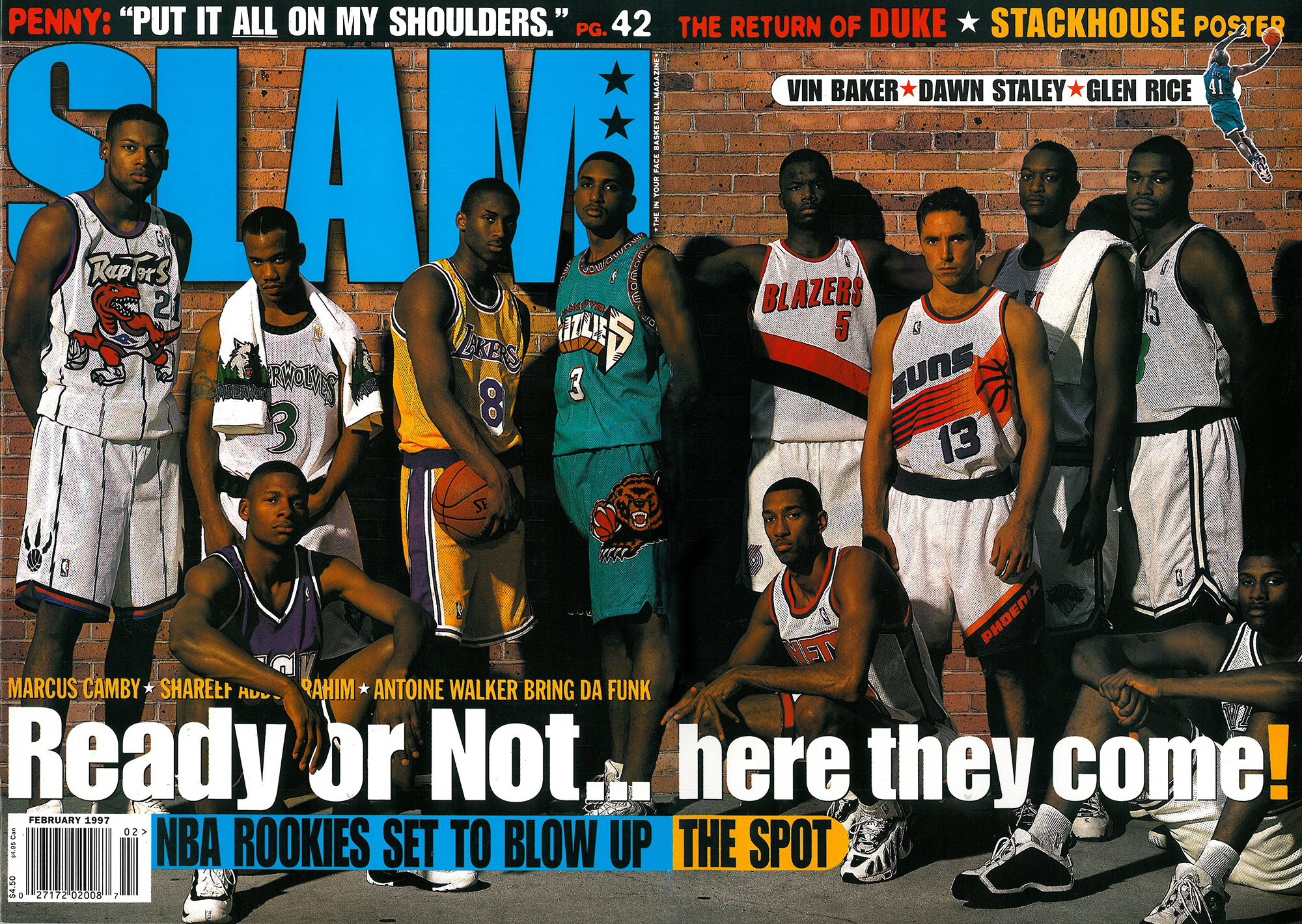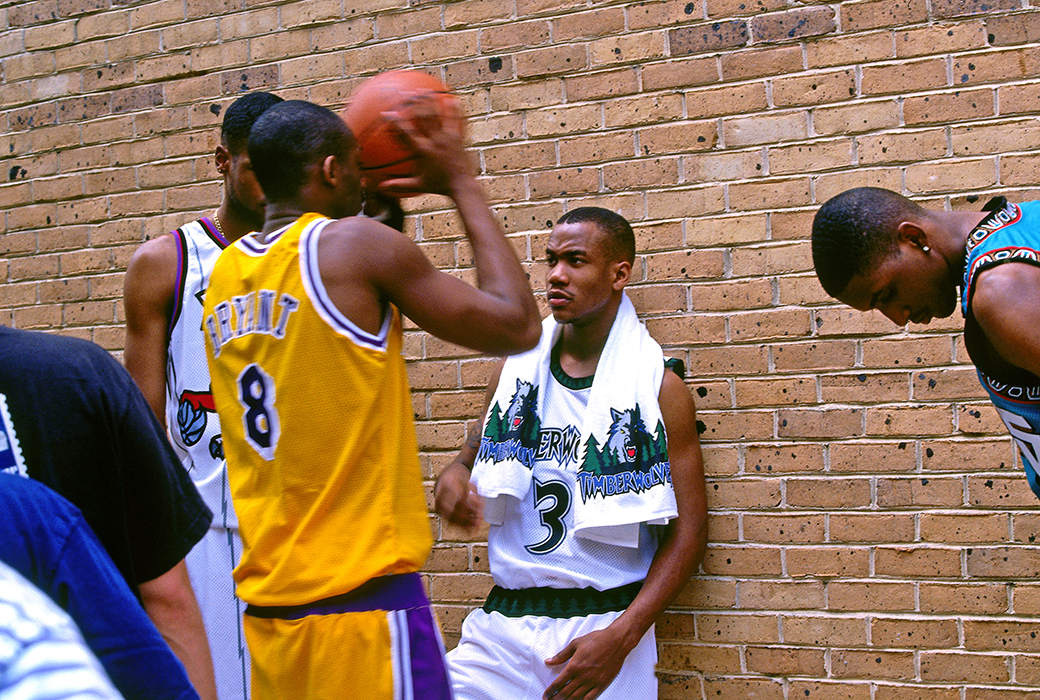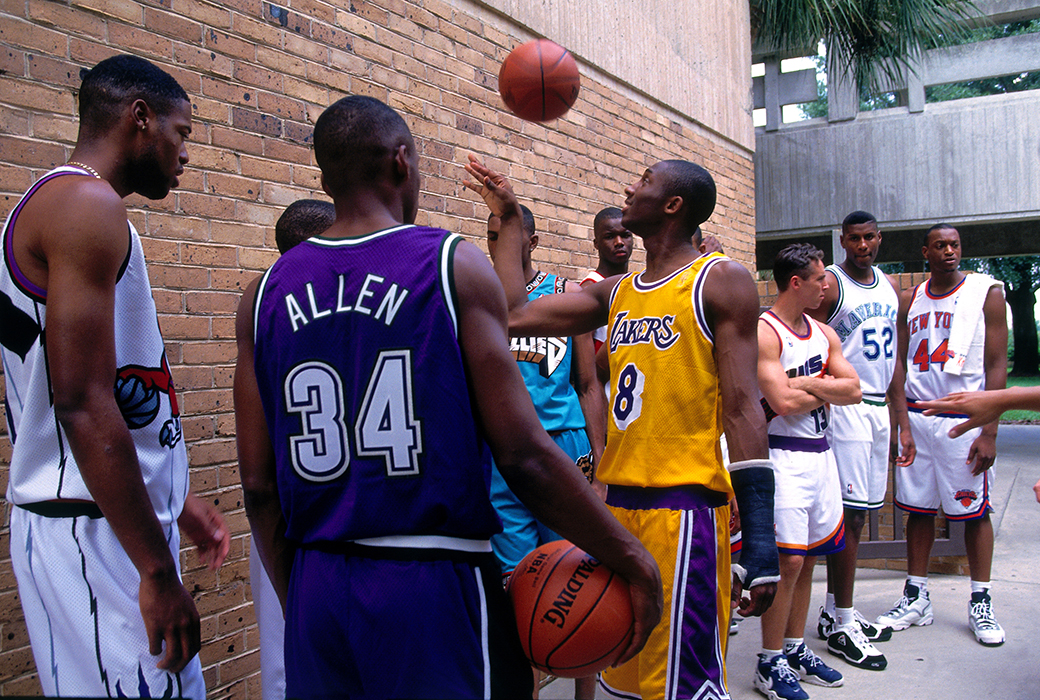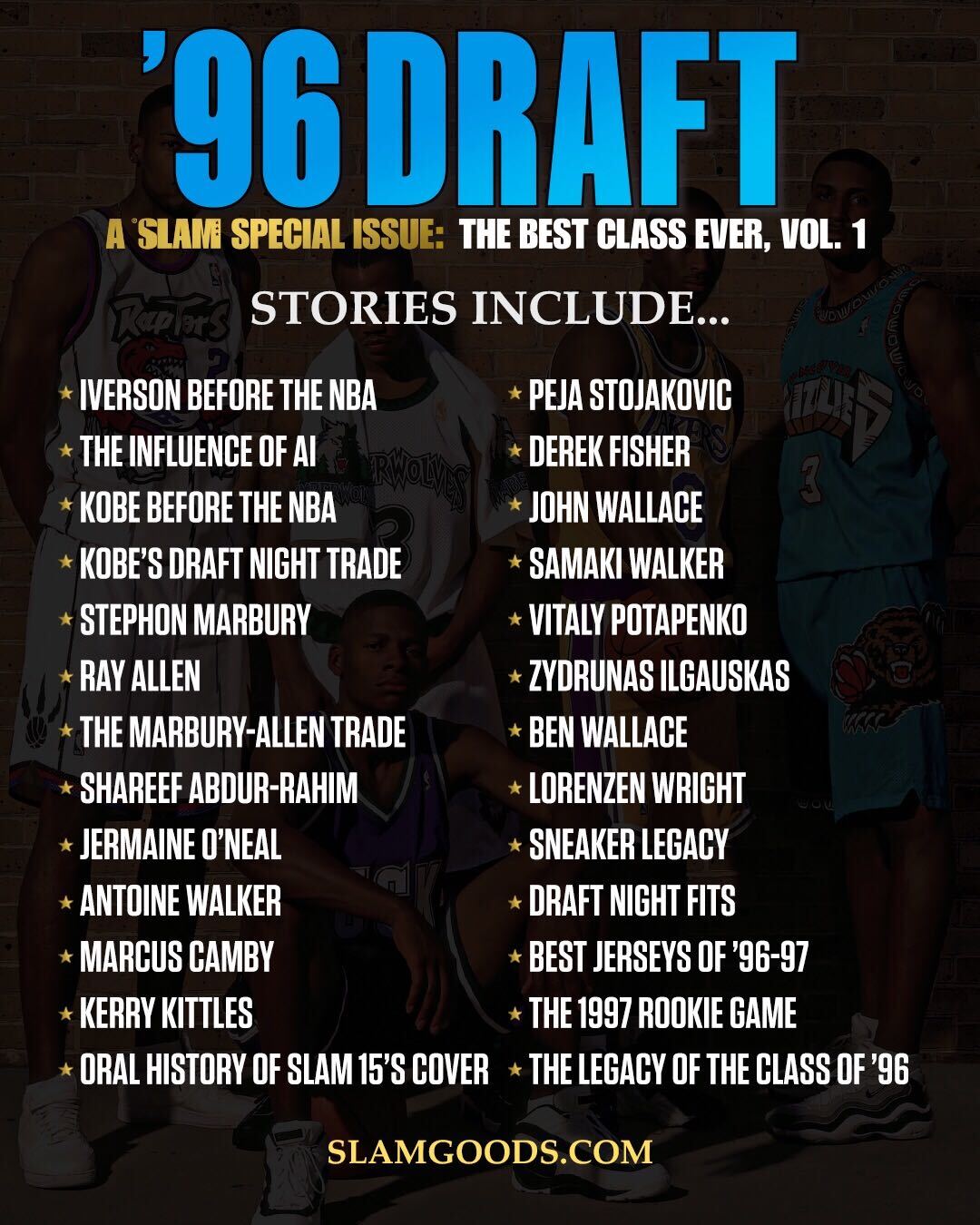This story appears in a magazine dedicated to the most iconic draft class ever. Get your copy.
Everything came together in 1996.
It was two years after SLAM had been founded, and the staff had built an identity as the “in-your-face” basketball magazine, seamlessly blending the worlds of hoops and hip-hop. Some fans caught on right away, understanding the mission and the voice. Others were a little more wary, unsure of how those two cultures overlapped or why it was necessary to bridge them.
Then 1996 happened. Hip-hop exploded with the release of several groundbreaking albums (see page 16), and one of the greatest NBA draft classes ever emerged on the scene, carrying with them the style, attitude, charisma and confidence that resonated with SLAM and its audience. That year pushed the brand forward in a massive way.
“You look at the music that was around, you look at the culture of basketball and us being right at the groundswell of trying to tell those stories that had been untold and how those stories about the culture of basketball are connected to the culture of hip-hop. And us being the voice of both of those at the time—yeah, ’96 was a special, special, special year,” says then SLAM Senior Editor Scoop Jackson.
To bring it all together was SLAM 15, and an iconic cover photo featuring future All-Stars, MVPs, champions and Hall of Famers. This is the behind-the-scenes story of how that cover came to be.
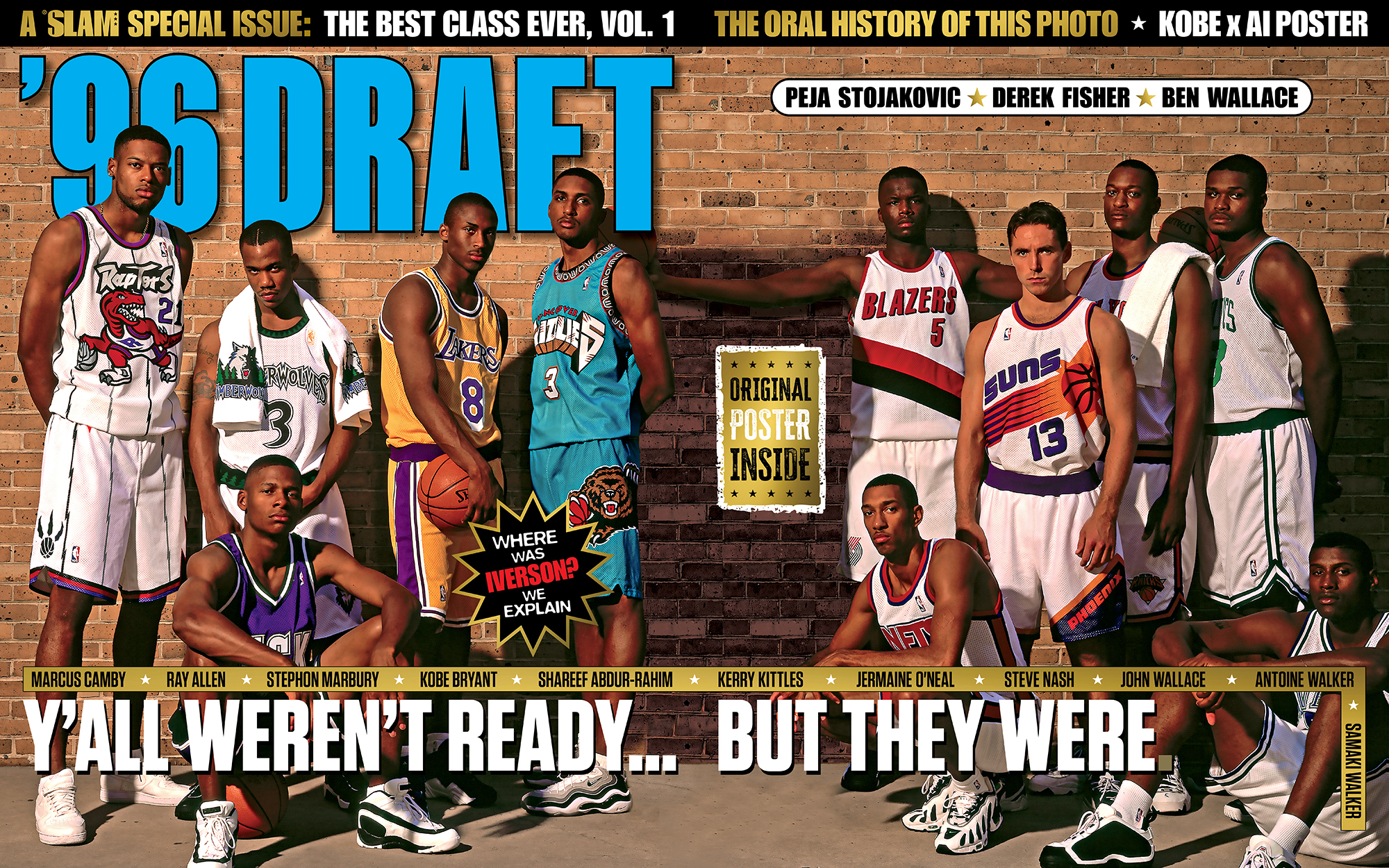
THE IDEA
By 1996, SLAM was well known throughout the basketball universe. But the incoming NBA rookie class, which SLAM had been covering for years, had a deeper connection to the brand. From those relationships, the staff understood two things very clearly: 1) This group had the potential to be extremely special, and 2) SLAM had the unique opportunity to be a part of their ascension.
Tony Gervino (then SLAM Editor-in-Chief): It was to a point where none of the [’96 class] didn’t know what SLAM was. Among the players, it resonated with them. Some of them we had done stuff with already. Stephon Marbury, we knew him since he was 15. Same with Kobe.
Jackson: We knew that class was deep, but we had no idea that class was going to be that class. But because of Stephon and Allen [Iverson], that class had a direct connection to the culture of hip-hop [with] how they represented themselves and how they were received. So we were putting that cover together with the impetus being that Stephon and Allen are the two players that directly identify with what SLAM is about.
Dennis Page (Publisher of SLAM): Everybody knew the draft class was dope. These were our guys. It was really Iverson and Marbury. Marbury and Iverson. The cover was a no-brainer. It was more about logistics than the idea. Could we actually pull it off?
Russ Bengtson (then SLAM Senior Editor): You knew going in it was a big draft. I wanna say the top six were the really big, like, We need to be in this range of picks to get the immediate impact guys. Iverson, Steph, Ray Allen, Marcus Camby, Shareef Abdur-Rahim and Antoine Walker. But it was just so deep because of Kobe and Jermaine O’Neal and Steve Nash and Kerry Kittles. It was one of the first drafts where it involved guys who were a part of SLAM since SLAM started. Stephon Marbury going into the draft was just such a huge moment for us as a publication because we featured him from the first issue.
Stephon Marbury: First of all, for me, doing anything with SLAM was always dope because I knew that SLAM was the magazine and it would be the magazine. I jumped on it early.
Nat Butler (NBA photographer who shot the cover image): Looking back at it now is one thing, but even at the time, everybody was such a stud. John Wallace at Syracuse was a stud. Camby at UMass was a stud. Marbury was a stud. Go down the line. Ray Allen, I was familiar with him from his UConn days. It was just one after the next.
Gervino: We knew it was a strong draft. My fear was that people would think, Oh, they put so many people on the cover because they’re hedging their bets. They don’t know who’s going to be good so they’re just putting a bunch of guys on there. And obviously that was [wrong]. It was just an undeniably strong class. We were at a point where people knew who we were and we had an opportunity and I thought, These are like first-generation guys who grew up on SLAM.
THE SHOOT
The photo shoot took place in Orlando during a rookie orientation event shortly after the NBA Draft.
Page: The truth of the matter was, Fleer trading cards was one of our biggest advertisers at the time. And the lightbulb went off. I called my guy at Fleer and said, How do you shoot all your cards? How do you get everybody together at once? And he said that they have these [rookie] transition events, or whatever they were called. I was like, Oh cool, let’s call Joe Amati and Carmin Romanelli with NBA Photos and see if we can piggyback on Fleer’s shoot.
Gervino: The NBA photo guys let us know that the trading card companies were shooting in Orlando, and if we went down there, we might be able to set up against a wall and have, like, two minutes as they went to lunch. Because the players would go from company to company and then after they finished the last company, they were going to walk to lunch.
GRAB YOUR COPY OF SLAM PRESENTS ’96 DRAFT FOR EVEN MORE GOODIES FROM THE ISSUE.
Jackson: When we registered at the hotel, we couldn’t register in our own names. The NBA could not know we were there. [Senior Director of NBA Photos] Carmin Romanelli was like, Get me the [list of] players. He was the only one at the NBA who knew. The NBA had no idea where this shit was going down, what was going down. This was a straight-up covert operation. We had to literally register in the hotel under alias names because the NBA could not know we were there.
Butler: It was tricky because it was outside and we knew it was gonna be fast. We set up a couple lights. But again, it’s tricky when you don’t want someone else casting a shadow on the guy behind them or next to them. You can’t go too crazy. It can’t be in the bright sun either, because then the guys start squinting and we wanted that tough SLAM look.
Jackson: I was spraying the players with water bottles to make it look like they were sweaty. Seriously. And some of these cats I’m meeting for the first time.
Gervino: We had 90 seconds. I know people are always exaggerating when they tell stories but I’m telling you, these guys were walking out of one building and into another building for food and we just were sort of like, Hey, come over here against this wall. We literally had, like, five photos and this photo on the cover was the only one where Jermaine O’Neal was looking at the camera. Kobe had a cast on his arm so we had to put his arm behind his back. It happened 1, 2. So quickly.
Butler: We shot it on film. I was shooting 4×5, which is the big camera on the tripod. It’s not like we had 15 shots to choose from. We probably took six or eight pictures, and that’s always nerve-wracking when you’re doing groups. Somebody’s not looking, somebody’s laughing, somebody blinks. Statistically, you need to shoot a little bit more. But I would say we probably took under 10 frames. I think it was like six or eight frames and then it was, OK, that’s it.
Kerry Kittles: I remember they just pulled us all in and snapped it and that was it. It wasn’t like you were in there all day. I think we each had individual stuff that we were doing. And so we were all spread out in this big auxiliary gym. We were all running around, doing different shoots, because a lot of us had deals with the trading card companies. So we were doing stuff for that and then there was also NBA stuff as well. We were all spread out. Then they just grabbed us, put us all together and did the shoot and that was it.
Jackson: [Then SLAM Creative Director] Don Morris and Tony, they were like, Steve Nash’s head is too big and if we put him on the front cover, his head is going to cover up the L on SLAM and it’s going to look like SIAM. The reason Steve Nash is on the other end is because of the size of his head [laughs].
Jermaine O’Neal: It was great. I’m watching people like Allen Iverson—I already knew Kobe—Stephon Marbury, Marcus Camby. I’m watching these people on television go to work. Ray Allen—I knew Ray from high school, we played each other. Antoine Walker, I watched on television. So it was a surreal moment. I was very quiet at the time. My demeanor was always quiet at a young age but I didn’t put up with no bullshit. I was an inner-city kid who only knew one way. And we had a great time. The photo shoot was fantastic, everybody was super cool.
Steve Nash: I remember Kobe had so much swag and confidence. I hate to use the word swag, he had that—what’s a better word—confidence maybe doesn’t do it justice. I don’t know, maybe some of it was projecting because he was young, 17 years old, he either knew that he belonged at 17 or was hellbent on projecting that because he knew he’d get there. But he right away had that confidence. Jermaine was confident but much more quiet—he was kind of more what you would expect of a high school kid.
Gervino: These were the players we wanted to grab. This was the list of guys. We had to separate some of the people who tried to get into the photo that we didn’t really want in the photo.
[Todd Fuller, a 6-11 center out of NC State who was the No. 11 pick in the ’96 Draft, was one of those people. His name would go on to become a code among the SLAM staff.—Ed.]
Gervino: If any of us were at a photo shoot and somebody just said, “Todd Fuller,” that meant somebody was trying to get into the photo and we have to get them out. You’d shoot like the starting five and then the PR people would be like, Oh, here’s the sixth man, coming into the shoot while you were trying to take the photo. It was more common than not.
Jackson: The backstory that I’m pretty sure nobody told you is that this shoot is what started XXL Magazine. In order to get [the SLAM cover] done, we had to literally sketch the whole thing out and present it to Carmin Romanelli, like, Here are the players we need. So we’re at the bar the night before picking the players that we want and sketching out the layout for this cover. And as we’re doing this, Don [Morris] is like, I’m so fucking sick of basketball. If we don’t do something else, I’m done with this shit. Don needed another outlet. We’re sitting there having cocktails like, Alright, well let’s think of some shit that we’re going to do. That’s where we came up with the concept for XXL. The entire concept came from right there. As we’re drawing up the [’96 Draft cover], we’re actually conceptualizing what wound up being XXL.
“IVERSON LEFT”
There was only one thing missing from that legendary cover shoot: The No. 1 overall pick in the draft, Allen Iverson.
Gervino: I went to sleep and at 7:00 a.m. my phone rang in my hotel room. I answered it and it was somebody from NBA Photos and all he said was, “Iverson left.” And I thought, Ughhh. Because I was literally, like, “No one let Iverson leave.” I was worried he wasn’t going to show up [to Orlando]. And then when he showed up, I was worried he was just going [to leave]. Because the night before they had that, like, Let’s bring the veterans in to talk to the rookies about what they have to do in life. I thought that would be something where [Iverson] would probably be like, I’m out of here. And the next morning he was gone.
Page: When we found out he bounced, that was the “Oh fuck” moment. It was still such an interesting concept that how could we not do it? I’m sure I was freaked out by that, but I don’t think there was any turning back on it.
Marbury: Honestly, the thing that I remember the most is Allen’s ass not being there [laughs]. I was so mad. I was trying to get Allen so we could take the picture. Like, literally, trying to find his ass and get him up so that he could come and take the picture with us. He just would not get up. Allen was gone. I was trying to get him up but there was no Allen.
Butler: He was going to be sitting or kneeling next to Ray, right in the front between Kobe and Shareef.
Gervino: I just look at it and all I can see is where he would’ve been on that first cover. It would have been an incredible six guys on that cover.
Marbury: It’s never going to change. When people see that picture, it’s always going to be, like, Yo, there’s something weird about this picture. Where’s Allen at?
Bengtson: Would that cover be better with him on it? Sure. It would’ve been great to have the No. 1 pick on it. But I feel like the way it worked out just kind of adds to the story.
“CLASSIC”
When the issue hit newsstands, it got a lot of immediate, positive feedback. Its impact on SLAM, especially as the ’96 class became more and more iconic, cannot be understated.
Jackson: When we got the bluelines and the original shot back, we all knew when we saw this shit. It was our first gatefold, too. We knew right then. I’m not going to say that the reaction we got to the magazine was predictive, but we knew when we saw that, like, Oh, shit.
Marbury: When I saw it, I said, “Classic.”
Gervino: We got a lot of comments about this. I think I had to hide a box of these somewhere because everyone wanted it. We used to shoot players from different teams together at the All-Star Games between practices and stuff. This made it a lot easier because they understood that, being on different teams, they wouldn’t look like clowns in a photo. This also helped us to know how little time we would need to do something.
Shareef Abdur-Rahim: The legendary nature of that picture kind of points to what the class has become more and more over the years. I took that picture at 19 years old. And still, to this day, I see people [with it]. That picture is hanging up in the NBA offices—in the New Jersey office and in the New York office. It speaks to how relevant the class was and how legendary the class was.
Marcus Camby: I even have that framed in my house. That picture with all that great talent—that was something that I needed to cherish. It brings back memories.
Butler: People always ask about this. [The iconicness of the cover] has to do with the stature of SLAM as an entity. It has to do with the stature of the historic careers that the guys in the picture have all had. It’s just one of those things where everything kind of came together.
Jackson: For us to do that cover so raw, in an alley, on a brick wall, and then to tie in The Fugees with “Ready or Not.” That presentation basically embodied everything that was going on in both hip-hop and basketball culture at that time.
Gervino: I just remember it sort of telling everyone else, “Ready or not, here we come, too.”
Bengtson: Even when we would do covers with one dude, it’s like, Oh man, I hope this guy doesn’t get hurt or traded before this issue comes out. Doing something like that with 11 guys—you’re just like, Wow, anything can happen at this point. That was a fortunate one where it made sense when we thought about it, it made sense when we did it and it’s only gotten better with time.
O’Neal: I never knew at the time that was gonna be one of the most iconic covers in draft history.
Page: For me, this is certainly one of the most important covers we’ve ever done because that class is so great. The question really becomes, truthfully, is it the greatest draft class ever?
Abdur-Rahim: We were kids. We were just having fun. If you think about it, the thing that’s changed is—in today’s world, you couldn’t get that group together to take a picture. I’m not saying us now at 40-plus years old. I’m saying that group of guys, minus the No. 1 pick, it’d be very difficult to get that group of kids together, [picks] 2-10, to take a picture at any point. Because you’d have so many different people like, Oh, that’s not good for your brand. There’s so many reasons why not to do it. Or, I just want to do a SLAM picture by myself. That stuff didn’t even cross anybody’s mind. It was, like, Yeah, let’s go take the picture.
—
